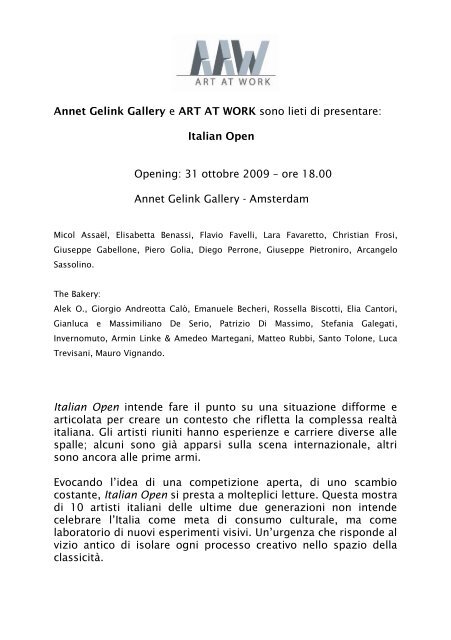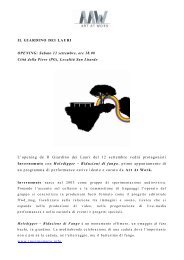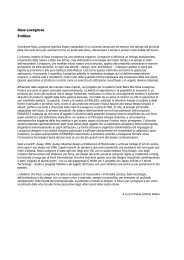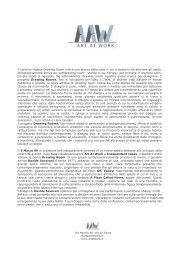Italian Open - Art At Work
Italian Open - Art At Work
Italian Open - Art At Work
Create successful ePaper yourself
Turn your PDF publications into a flip-book with our unique Google optimized e-Paper software.
Annet Gelink Gallery e ART AT WORK sono lieti di presentare:<br />
<strong>Italian</strong> <strong>Open</strong><br />
<strong>Open</strong>ing: 31 ottobre 2009 – ore 18.00<br />
Annet Gelink Gallery - Amsterdam<br />
Micol Assaël, Elisabetta Benassi, Flavio Favelli, Lara Favaretto, Christian Frosi,<br />
Giuseppe Gabellone, Piero Golia, Diego Perrone, Giuseppe Pietroniro, Arcangelo<br />
Sassolino.<br />
The Bakery:<br />
Alek O., Giorgio Andreotta Calò, Emanuele Becheri, Rossella Biscotti, Elia Cantori,<br />
Gianluca e Massimiliano De Serio, Patrizio Di Massimo, Stefania Galegati,<br />
Invernomuto, Armin Linke & Amedeo Martegani, Matteo Rubbi, Santo Tolone, Luca<br />
Trevisani, Mauro Vignando.<br />
<strong>Italian</strong> <strong>Open</strong> intende fare il punto su una situazione difforme e<br />
articolata per creare un contesto che rifletta la complessa realtà<br />
italiana. Gli artisti riuniti hanno esperienze e carriere diverse alle<br />
spalle; alcuni sono già apparsi sulla scena internazionale, altri<br />
sono ancora alle prime armi.<br />
Evocando l‟idea di una competizione aperta, di uno scambio<br />
costante, <strong>Italian</strong> <strong>Open</strong> si presta a molteplici letture. Questa mostra<br />
di 10 artisti italiani delle ultime due generazioni non intende<br />
celebrare l‟Italia come meta di consumo culturale, ma come<br />
laboratorio di nuovi esperimenti visivi. Un‟urgenza che risponde al<br />
vizio antico di isolare ogni processo creativo nello spazio della<br />
classicità.
L‟arte <strong>Italian</strong>a vive di successivi rinnovamenti e il pericolo è quello<br />
di non capire che esistono nuovi attori sul palcoscenico, soggetti<br />
che devono essere messi in condizione di contribuire alla<br />
costruzione di nuovi linguaggi. Questa opportunità permette una<br />
trasformazione fondamentale del soggetto «italiano» in soggetto<br />
«internazionale», capace di contribuire non solo al cambiamento<br />
della propria espressività, ma anche di essere parte attiva di una<br />
dialettica globale. Ideologia, abilità, tecnologia e nostalgia si<br />
incontrano nei lavori in mostra e raccontano il pianeta Italia.<br />
<strong>Italian</strong> <strong>Open</strong> intende mostrare questo fenomeno di intrecci non<br />
ancora ben tessuti, di anomalie rimaste troppo conformi e di<br />
contaminazioni le cui origini sono tuttora troppo evidenti, dove la<br />
mescolanza non si è compiuta del tutto. L‟artista italiano sembra<br />
essere rimasto fedele ad un modello di umanesimo che ha<br />
privilegiato l‟individuo rispetto alla collettività, alla folla etnica.<br />
L‟artista italiano è un eterno giocatore brechtiano, che per salvare<br />
la sua libertà interiore rinuncia a far parte di qualsiasi gruppo. La<br />
complessità forse è la nostra unica ricchezza, in contrasto ad una<br />
tradizione con la quale rimane difficile confrontarsi.<br />
<strong>Italian</strong> <strong>Open</strong> è quindi la metafora di un torneo, di una partita<br />
aperta. Non si tratta di stabilire quanti arriveranno alla fine del<br />
„gioco‟, tuttavia è lo scontro-incontro a diventare l‟obiettivo di<br />
questa generazione. <strong>Italian</strong> <strong>Open</strong> parte dal presupposto che la<br />
definizione «arte italiana» sia allo stesso tempo obsoleta e<br />
fondante per descrivere ciò che succede nel territorio italiano,<br />
partendo dalla condizione diversificata e complessa dei suoi<br />
giovani talenti. Tutti gli artisti di <strong>Italian</strong> <strong>Open</strong> vivono il conflitto fra<br />
l‟auto-rappresentazione in quanto italiani e il desiderio di<br />
un‟espressione internazionale che esuli dall‟idea di confine.<br />
Analizzata attentamente, la loro produzione mostra affinità e<br />
dialogo con quella internazionale, ma soprattutto evidenzia un<br />
individualismo poetico-formale e un eclettismo unici al panorama<br />
nazionale.
31 ottobre – 19 dicembre 2009<br />
Annet Gelink Gallery<br />
Laurierstraat 187-189<br />
NL-1016 PL Amsterdam<br />
The Netherlands<br />
www.annetgelink.nl<br />
dal martedì al venerdì 10.00 – 18.00<br />
sabato 13.00 – 18.00<br />
tel 31 20 3302066<br />
fax 31 20 3302065<br />
Via Mazzini, 40 - 10123 Torino<br />
T.+39.011.19715285 F.+39.011.19715876<br />
mail@artatwork.it www.artatwork.it
Annet Gelink Gallery and ART AT WORK are pleased to present:<br />
<strong>Italian</strong> <strong>Open</strong><br />
<strong>Open</strong>ing: 31 st October 2009 – 6pm<br />
Annet Gelink Gallery - Amsterdam<br />
Micol Assaël, Elisabetta Benassi, Flavio Favelli, Lara Favaretto, Christian Frosi,<br />
Giuseppe Gabellone, Piero Golia, Diego Perrone, Giuseppe Pietroniro, Arcangelo<br />
Sassolino.<br />
The Bakery:<br />
Alek O., Giorgio Andreotta Calò, Emanuele Becheri, Rossella Biscotti, Elia Cantori,<br />
Gianluca & Massimiliano De Serio, Patrizio Di Massimo, Stefania Galegati,<br />
Invernomuto, Armin Linke & Amedeo Martegani, Matteo Rubbi, Santo Tolone, Luca<br />
Trevisani, Mauro Vignando.<br />
<strong>Italian</strong> <strong>Open</strong> aims to make a point on the diverse and articulated<br />
artistic situation present in Italy, attempting to define a context<br />
able to reflect the complexity of the existing languages and<br />
practices. The selected artists all have different experiences and<br />
artistic careers; some of them have more of an international<br />
visibility, while others are still emerging.<br />
While evoking the idea of an open competition, of a continuous<br />
exchange, <strong>Italian</strong> <strong>Open</strong> leads to different readings. This exhibition<br />
of 10 <strong>Italian</strong> artists of the most recent generations, does not<br />
intend to celebrate Italy as a destination of cultural consumerism,<br />
rather places itself as a workshop of new visual experiments: an<br />
urgent reply to the antique habit of isolating the cultural process<br />
to the realm of classicism.
<strong>Italian</strong> art exists through a number of subsequent renewals and<br />
the danger is that of not understanding the presence of new<br />
actors on scene: subjects that need to have the conditions to<br />
contribute to the construction of new types of languages. This<br />
latter state permits the significant transformation of the subject<br />
from being “<strong>Italian</strong>” to becoming “International”, able not only of<br />
changing a personal way of expression, but also of being part of a<br />
global dialectic. Ideology, ability, technology and nostalgia<br />
dialogue in the works on show and narrate the <strong>Italian</strong> atmosphere.<br />
<strong>Italian</strong> <strong>Open</strong> intends to show this complex phenomenon of<br />
interweaving, which is still not completed, adequate anomalies<br />
and contaminations whose origins are yet too evident, where the<br />
composition has not been accomplished. The <strong>Italian</strong> artist seems<br />
to have remained faithful to a humanistic model which has<br />
privileged the individual in comparison to the community, to the<br />
ethnic crowd. The <strong>Italian</strong> artist is an eternal Brechtian player, who<br />
renounces to take part in any kind of group in order to save his<br />
own personal freedom. The complexity perhaps is our only<br />
richness, in contrast to a tradition difficult to confront.<br />
<strong>Italian</strong> <strong>Open</strong> is thus the metaphor of a tournament, of an open<br />
match. The important aspect relies not in establishing how many<br />
will arrive at the end of the „game‟, as the collision-encounter is<br />
the focus of these generations. <strong>Italian</strong> <strong>Open</strong> claims that the<br />
definition “<strong>Italian</strong> <strong>Art</strong>” is at the same time obsolete and<br />
fundamental to describe what is happening on the <strong>Italian</strong> territory,<br />
taking it steps from the diversity of its young talents. All the<br />
artists participating in <strong>Italian</strong> <strong>Open</strong> live a conflict between selfrepresentation<br />
as <strong>Italian</strong>s and the desire of an international way of<br />
expression that goes beyond the idea of border. If carefully<br />
analysed, their production shows affinity and dialogue with the<br />
international one, but mainly evidences a poetic-formal<br />
individualism and an eclecticism unique to the national panorama.
31 st October – 19 th December 2009<br />
Annet Gelink Gallery<br />
Laurierstraat 187-189<br />
NL-1016 PL Amsterdam<br />
The Netherlands<br />
www.annetgelink.nl<br />
tuesday to friday 10 am - 6 pm<br />
saturdays 1 - 6 pm<br />
tel 31 20 3302066<br />
fax 31 20 3302065<br />
Via Mazzini, 40 - 10123 Torino<br />
T.+39.011.19715285 F.+39.011.19715876<br />
mail@artatwork.it www.artatwork.it
<strong>Italian</strong> <strong>Open</strong><br />
MICOL ASSAEL, 19-06-2008 | 2008 | ink on antique paper | 25.3 x 20.3 cm<br />
ELISABETTA BENASSI, "CHE FARE?" | 2009 | Morse code lamp | 45 cm / Variable dimension
ELISABETTA BENASSI, SENZA TITOLO | 2009 | Watercolor on cardboard | 141 x 184 cm<br />
FLAVIO FAVELLI, INTERNO CHINA | 2008 | Plastic crates, ceramic vases, glass plate | 180x70x55 cm
FLAVIO FAVELLI, PLANISFERO (BLUE) | 2009 | Markerink on Emilio Pucci scarf | 90 x 90 cm<br />
FLAVIO FAVELLI, PLANISFERO (BLACK) | 2009 | Pennarelli su foulard Emilio Pucci | 86x86 cm
FLAVIO FAVELLI, PLANISFERO (RED) | 2009 | Pennarelli su foulard Emilio Pucci | 90x90 cm<br />
LARA FAVARETTO, LOST&FOUND | 2009 | 1 Suitcase | 38x54x17 cm
LARA FAVARETTO, LOST&FOUND | 2002 | 1 Suitcase | 55x66x17 cm<br />
LARA FAVARETTO, LOST&FOUND | 2004 | 1 suitcase | 50x84x25 cm
CHRISTIAN FROSI, LLLLLLLLLLLI | 2009 | Rubber, parachute, nylon, metal | Variable dimensions<br />
GIUSEPPE GABELLONE, UNTITLED | 2009 | Digital print | 52x35 cm
GIUSEPPE GABELLONE, UNTITLED | 2009 | Digital print | 52x35 cm<br />
PIERO GOLIA, UNTITLED (RUG) | 2003-2007 | Spray paint on carpet | 200 x 140cm
DIEGO PERRONE, SENZA TITOLO | 2009 | Grafite, resin, acryl, iron | 130 x 110 x 270 cm<br />
DIEGO PERRONE, SENZA TITOLO | 2009 | Iron, epoxy, carbonfiber, fiberglass, ballpointink | 76x145x165 cm
GIUSEPPE PIETRONIRO, SHORT - CIRCUIT | 2009 | Lamba print mounted on aluminium, tripod, 18 aluminum floor tiles<br />
Lamba print: 130 x 210 cm<br />
ARCANGELO SASSOLINO, MACROSCOPICO E DOMESTICO | 2009 | Gascilinder, air, pvc | Variable dimenions
Installation view | Annet Gelink Gallery, Amsterdam<br />
Installation view | Annet Gelink Gallery, Amsterdam
Installation view | Annet Gelink Gallery, Amsterdam<br />
Installation view | Annet Gelink Gallery, Amsterdam
Installation view | Annet Gelink Gallery, Amsterdam<br />
Installation view | Annet Gelink Gallery





